Winter gardening to save summer watering
Planning ahead in winter can save watering in the summer, and help you grow better plants. Horticultural scientist Janet Manning shares her insights to help make your garden more resilient to extreme weather, which will save time and water. It’s not about drastic changes, but with a little scientific knowledge, making the most of what nature provides.
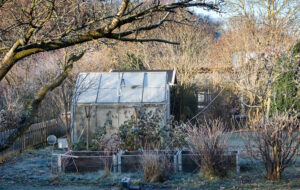
By planning ahead in winter we shouldn’t need to keep pouring water on in the summer
Gardeners can have quite short memories when it comes to the weather. Not that many months ago we were desperately hoping for rain, and the temperature to drop just a little for some respite from the heat. Now we’re asking for explanations why, despite the rain, hosepipe bans were not lifted sooner. With depleted soil moisture last summer some reservoirs won’t refill until soils are fully re-wetted, which could take some months. What is clear from all this is that we can’t expect to simply keep pouring more water on every summer, and crucially we shouldn’t need to if we plan ahead.
It is now, with a chill in the air, moisture in the soil, leaves on the ground and water falling from the sky for free, that we are able to prepare for the next dry spell, or hosepipe ban. In fact conserving our water is still very much needed; there is still a hosepipe ban in place in Cornwall, with reservoirs well below 50% full. So what can you do now to make your garden more water efficient and resilient to dry spells?
Install a water butt, and another one!
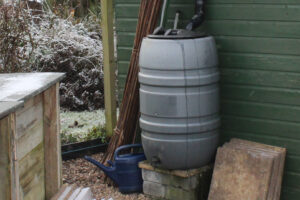
In dry Essex, one side of a shed roof can still collect 1000 litres a year
Water butts are the obvious way to reduce the amount of mains water you use in the garden. But let’s be honest, they soon run out if you are gardening in the ‘traditional’ ways; tidying and clearing and planting annual plants. So why not add an extra butt? You can fix up an extra water butt at any time, but the best time to fill it is in the winter months.
If you are using a rainwater diverter, it needs to be installed level with the top water level in the water butt, not higher than the butt. Otherwise you will flood your garden once the butt is full, rather than the water returning into the down pipe.
If your plot is reasonably level, you can place a water butt wherever you like and connect them together with a siphon, from a single rainwater diverter on the downpipe. No plumbing or tools are required, you just need a length of hose to reach from the bottom of one butt to the bottom of the other. Don’t forget to weight the ends of the hose to avoid losing the siphon. As long as the hose has no air in it, and the two butts are more or less level with each other, they will happily transfer water from one butt to the other, in both directions, automatically!
You can avoid the water becoming stale by using it to wash your car in the winter. This will also leave space for the next rainfall rather than it running off into drains where it’s really not needed. You don’t need a large roof either. For example, Essex is one of the driest counties, but a 2.4 x 1.8 m (6ft x 8ft) shed or greenhouse can collect around 1000 litres water in a year, from only one side of the roof. And a good rain shower in the summer could easily collect 50 litres.
It’s all about soil moisture
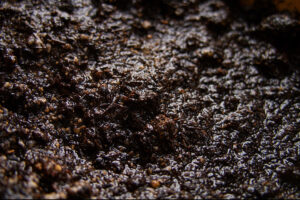
The average UK garden has around 38,000 litres held in its soil!
Nature doesn’t have water butts, or an irrigation system, and it never digs the soil, clears away dead leaves and stems nor allows the surface of the soil to be left bare, (unless it’s a desert). We create work by trying to do all of these things! If plants don’t like growing in a particular place, nature will sacrifice them and allow something more resilient to grow. As gardeners, we need to get in tune with these things. If you want your garden to be more climate resilient, build resilient soil first and then consider water butts and drought adapted plants.
The average UK garden might only have one or two water butts (about 400 litres worth of water) but healthy, un-dug and deeply aerated garden soil will be holding onto about 40% of its volume as water. That means the average garden has around 38,000 litres held in its soil, equivalent to 190 water butts, topped up by nature, every time it rains! The key is encouraging water into the soil, keeping it there, and growing plants with roots that can reach it.
What happens in soil
Nature intends the rain to get into the soil, where it nurtures plants and soil dwelling organisms, moving soluble nutrients around for plants and animals. Rain also displaces the stale air in soil. Freshly oxygenated air is pulled into the root zone once the water drains into the deeper layers and down into the aquifers. That oxygen supply then helps the bacteria make sure the nitrogen and phosphorus are in the right forms for your plants to use.
Making your soil healthy
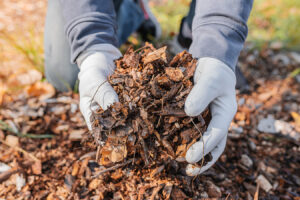
The key to healthy soil is large pores that gets water and air to the roots
The key is to get deep draining soil, with large pores between the soil crumbs to allow space for both air and water to move around. This can be achieved either by growing in a loose, stony, inorganic material such as crushed concrete or coarse sand, or by adding a surface mulch of organic material such as leaves, homemade compost, wood chip or cardboard. This provides food for the soil organisms such as earthworms (the gardeners best friend), as they will drag this material into the depths of the soil, while also opening their burrows for water to drain into. The pores made in the soil help air and water move into the root zone and this is what is meant by healthy soils.
Give your lawn a helping hand

Hollow tining isn’t the same as spiking with a fork
The winter is the time to get ahead with lawn care, or rather soil care, to avoid brown dry lawns appearing quite so early next summer. When you walk on your lawn you compact the soil, squashing all the air out of those macropores, leaving no space for the rain to infiltrate. The process of ‘hollow tining’ will remove small cores of soil from the lawn so that rain can penetrate, and air reaches the root zone. Just make sure the ground isn’t waterlogged or frozen. Spiking with a fork is not the same as hollow tining as it will compact the soil around the tines as you rock the fork, squishing more air out of the soil. A hollow tine aerator would make a fine present for a lawn fanatic who has been using a lawn sprinkler during the summer!
Hollow tining may not be needed every year because soil dwelling creatures will get to work; creating burrows that act as drainage, ventilation channels and a crumb structure that will withstand more footfall. These creatures also need food, provided by dead grass or mowings that lie on the surface of the soil, otherwise known as thatch. These leaves and dead grass will be dragged into the soil by the worms, feeding and providing nutrients to grow more grass and start the cycle over again. Thatch should be digested into the soil, reducing the amount of rain that would otherwise run off the surface of the dead layer of grass.
Insulate your plants
Most plants will benefit from a light mulch of organic matter in winter, insulating the roots from very cold weather. Use carbon rich mulches such as wood chip and bark now, and save the more nutrient rich homemade compost or manure for the spring. This will avoid losing valuable nitrogen in the winter rains.
Grow deep roots in winter
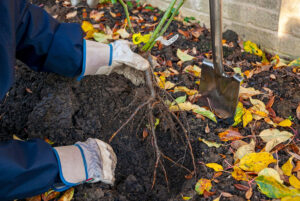
Save on watering by planting out bareroots, trees and hedges
It’s the time to plant hardy bareroot plants, hedges or trees instead of leaving them in containers. Just make sure the ground isn’t frozen or waterlogged. While their leaf canopies are dormant (which use quite a bit of water), these plants can establish deep root systems before the surge of growth in the spring.
It can take four to ten years to grow a tree in a container, watered by the grower for all that time, which could amass quite a water footprint. You could also lose a tree in a container in a very dry summer, if it hasn’t had the benefit of a winter of moist soil to establish deep roots. Save on watering and replacement plants by buying a smaller tree and adding a mulch of organic material when you plant it, which will protect the roots from cold and keep moisture in the soil. Perhaps there should be a law that every containerised tree should be sold with a bag of mulch.
Don’t turn compost
Finally, please don’t turn your compost in midwinter as there could be creatures hibernating from the frost and snow in there. Just like no-dig gardening, no-dig compost can work if there is air available to these creatures as they will do the work for you.
To recap
- Install water butts and if you can, connect them together with some hose. Make sure that all rainwater diverters are installed correctly.
- Healthy soil will make the most of the rain. Allow space for air and water to move by adding inorganic material or mulch.
- Hollow tine your lawn to help it stop going brown so quickly. Encourage soil dwelling creatures with mowings and thatch.
- Insulate plants with carbon rich mulch in the winter, to avoid losing nitrogen.
- Save on watering by planting out bareroots, hedges and trees, so their roots have time to grow.
- Help hibernating creatures by not turning your compost.
Check out more blogs from Janet on how to grow better plants while saving time and water.
BackAdopt the pace of nature: her secret is patience
– Ralph Waldo Emerson, American philosopher and abolitionist
